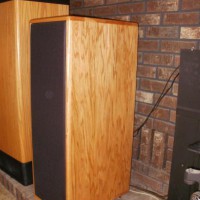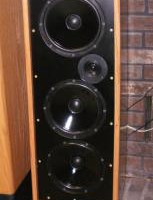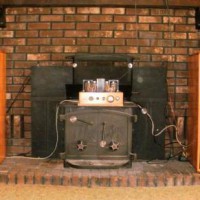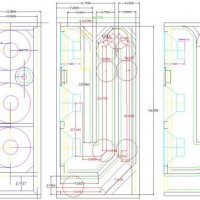Transmission Line MTMM Array
Designer: Nanook
Project Time: 20+ hours
Project Complexity: Hobbyist
Project Cost: $100-$500
Driver Selection
Tweeter is a Peerless Silk dome 8 Ohm LR19DT-8. I’ve used them in other projects and enjoy their detail without experiencing listening fatigue. The woofers are the Peerless 8″ 12 Ohm W8-12T 12P that were on the factory buyout list. Efficient at 91.5 dB 1W/1m and with 3 in parallel, 4 Ohms.
Enclosure Design
External dimensions are approx 12″x16″x36″. Decreasing cross section labyrinth termination. ~90″ acoustical path and ~84 L internal displacement. Solid Oak top and bottom with 1/4″ 9ply mahogany marine plywood laminated to the bottom to prevent warping and to dampen resonance. 3/4″ oak plywood sides with solid front and back caps to allow for 3/4″ rounding. Internal braces and panels are 3/4″ MDF .
Amplifier/Crossover Configuration
Dayton Audio XO2W-2.5K 2-Way Speaker Crossover 2,500 Hz. Jumper-ed for the 4 Ohm woofer option. Baffle step filter was added with an L-Pad to help make it adaptable for various room configurations. Sweep tube amp performance verified on both 4 Ohm and 8 Ohm taps. Good sound stage and clarity in both configurations.
Enclosure Assembly
The 15-7/8″x 35″ plywood sides were trimmed on the table saw and fabricated first by gluing 3/4″ x 3/4″ solid oak to the plywood edges on the front and back for a 16″ width. All of the sides were end trimmed to 34″ length to match. The tops and bottoms were solid oak laminated with alternating grain to prevent warping. They were put through the first sanding marathon and cut to size 12″x 16″ . ( 10.5″ inside width) 36″ clamps were used for top and bottom assembly. The top and bottoms were glued onto one of the sides with a little overhang to allow for the overhang to be trimmed flush with a router. All of the MDF internal pieces for both speakers were cut at one time to ensure proper assembly. The top was reinforced with 1/4″ 9ply plywood on the inside to prevent warping and splitting. Another piece was cut for lamination to the bottom. The internal labyrinth was assembled, dry fit and then glued in place. Once dry, they were coated/ glued up with 1/2″ under-carpet foam. I would recommend wool felt instead. The remaining side was glued in place so the basic box was completed. The front and back are screwed in place to 3/4″ x 3/4″ frames that are fitted in place to allow for the grill in front and foam to seal the back. The outside edges were routered with a 3/4″ round over bit. The front board is 2 3/4″ MDF sheets laminated together. The Jasper Jig makes short work out of cutting the mounting holes. I used a router on the back side to flare the woofer openings. The completed assembly was epoxy coated with 2 coats. It seals all of the edges and helps to stiffen the assembly. The back was also epoxy coated prior to black satin painting. The completed front board was drilled and screwed in place and then removed for the crossover and 1/2″ wool felt to be installed. I used a W pattern to try to soak up the midrange and prevent reflections. Acousta-Stuf was added every 1.5′ to try to adsorb the 1/5th harmonic energy. The terminal cup, L-Pad and the Baffle step filter was added to the back and installed. The grills were fabricated from 3/4″ x 3/4″ clear pine with 1/4″ 9ply triangles added for the plastic grill guide mounts. Brad point drills do a nice job for grill guide installation. Spray the wood with several coats of black paint prior to cloth covering. I use glue sticks to put a thin line of glue on the back and inside edge of the frame. Stretch the fabric over the frame and used a small iron to melt the glue under the fabric. Trim and iron to the inside edge to finish. The boxes were put through a sanding marathon, sealed, stained and coated with 8 coats of a Spar Urethane-Tung-oil finish blend…. I wanted the durability of Urethane with the ease of application of tung oil. Tung oil extends the working time, mineral spirits thinned the blend for a thinner coat. ( Note: in cold weather read the instructions for possible product limitations, glues for example)
Conclusion
The woofers were a little tight and are breaking in and bottom end is improving over 50hrs of listening. Low end is surprising and controlled. TL speakers do take longer to fabricate, but I have a preference for them. Tuning takes time as the woofers break in.
About The Designer
Schooled at DeVry, work experience includes linear design and characterization at National semiconductor, Digital at Intel, Hybrid circuit integration at Cermatek, Analog circuit designs at Honneywell, Space Flight Electronics at TRW/CE.






+ There are no comments
Add yours